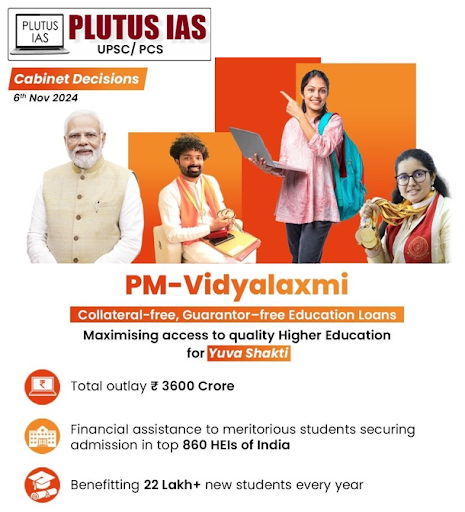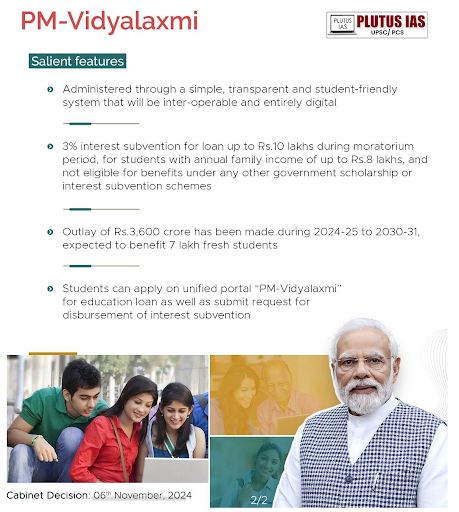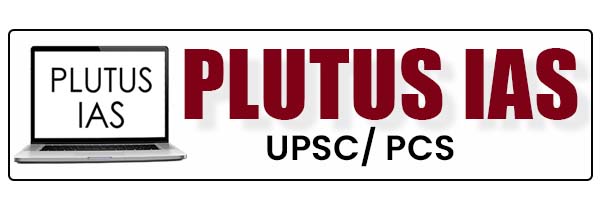07 Nov PM Vidyalaxmi: A Pathway to Accessible and Affordable Higher Education
This article covers “Daily Current Affairs” and topic details PM Vidyalaxmi Scheme.
Syllabus mapping:
GS-2: Social Sector Management: Issues related to health, education, and human resources, along with challenges of poverty and hunger.
For Prelims:
What are the key features of the PM Vidyalaxmi Scheme? What are the various schemes related to higher education?
For Mains:
What is the significance of the PM Vidyalaxmi scheme, what are the challenges in higher education, and what are the solutions to improve higher education in India?
Why in the news?
The Union Cabinet, led by Prime Minister Narendra Modi, has approved the PM Vidyalaxmi scheme, a major new initiative to provide financial support for meritorious students pursuing higher education.

Key Features of the PM Vidyalaxmi Scheme
Alignment with NEP 2020: Launched by the National Education Policy (NEP) 2020 to provide financial assistance to deserving students, promoting greater access to quality education.
Mission Mode Mechanism: A focused system to facilitate education loans for meritorious students admitted to the top 860 higher educational institutions (QHEIs), benefiting over 22 lakh students annually.
Special Loan Product:
Offers collateral-free and guarantor-free loans for eligible students.
Accessible through a simple, transparent, and fully digital application process.
Credit Guarantee:
75% credit guarantee by the government on loans up to ₹7.5 lakhs, encouraging banks to expand loan availability.
Interest Subvention:
3% interest subvention on loans up to ₹10 lahks for students with annual family incomes up to ₹8 lakh.
Complements the full interest subvention for students with family incomes up to ₹4.5 lakh under the PM-USP scheme.
Enhanced Access to Higher Education:
Builds on past initiatives to further maximize access to quality higher education for India’s youth.

Significance of the PM Vidyalaxmi Scheme
Financial Support for Meritorious Students: Enables talented students from economically weaker backgrounds to pursue higher education without financial barriers, promoting merit-based educational access.
Empowerment of Women Students: Provides targeted support to female students, encouraging higher participation of women in higher education and promoting gender equity in advanced fields of study.
Employment Generation: By supporting higher education, the scheme aids in producing a skilled and educated workforce, enhancing employability and contributing to job creation in diverse sectors.
Harnessing Demographic Dividend: Investing in youth education strengthens India’s human capital, enabling the country to fully utilize its large, young population to drive economic growth.
Poverty Reduction Through Education: Offers educational support to underprivileged students, equipping them with skills that enhance employability and lead to higher incomes, which in turn can break cycles of poverty.
Key Challenges for Higher Educational Institutions (HEIs) in India
Insufficient Funding: Government expenditure on higher education in India is about 2.7% of GDP, much lower than the 6% recommended by the Kothari Commission. This limited funding impacts infrastructure, faculty, and research opportunities within HEIs.
Inequitable Access: Despite efforts to expand higher education, disparities persist. According to data, Gross Enrolment Ratio (GER) in higher education stands at around 27.1% (AISHE 2019-20), with rural areas and marginalized communities having significantly lower access than urban or privileged groups.
Accreditation Constraints: Less than 20% of HEIs are currently accredited by the National Assessment and Accreditation Council (NAAC) and National Board of Accreditation (NBA) due to limited capacity and resource constraints in these bodies, leaving many institutions outside quality assurance frameworks.
Poor Learning and Teaching Outcomes: Studies show that over 50% of undergraduate students lack basic prerequisites in subjects like mathematics and science. This skill gap impacts the quality of higher education and affects students’ abilities to meet expected learning outcomes.
Low Levels of Research and Innovation: India ranks 40th in the Global Innovation Index (2023) and contributes to only 2.7% of global research publications. Additionally, only 6,000 patents were granted to Indian residents in 2021, compared to over 300,000 in China, reflecting challenges in research funding and infrastructure.
Absence of Global Competitiveness: Indian institutions struggle to achieve international standards. As of 2023, only 2 Indian universities are in the top 200 of the QS World University Rankings, highlighting a gap in global competitiveness.
Challenges in Attracting International Students: India ranks 26th as a global destination for higher education. While India sends around 750,000 students abroad annually, it attracts only 50,000 international students, limiting its global education appeal.
Mismatch Between Higher Education and Skill Development: Only 4% of skill training is provided by higher education institutions, while 58% is contributed by the Ministry of Skill Development and Entrepreneurship (MSDE). The lack of integration with MSDE means skill development in HEIs remains under-prioritized, creating a disconnect between education and job-market needs.
Way Forward for a Stronger Higher Education Ecosystem in India
Streamlining Regulation and Accreditation:
Simplify the regulatory landscape by consolidating and removing overlapping regulations to ensure a more efficient system.
Expand the accreditation network while acknowledging diverse educational standards to improve quality assurance across institutions.
Enhancing Access to Higher Education:
Increase accessibility for vulnerable communities by offering scholarships, fee reimbursement, and other financial support.
Use Massive Online Open Courses (MOOCs) and Open and Distance Learning (ODL) to reach geographically underserved regions, broadening educational opportunities.
Strengthening Higher Education Financing:
Introduce new revenue streams by opening sophisticated research equipment for industry and external users, which would improve utilization and generate income.
Provide one-time financial grants to fill faculty vacancies and infrastructural grants for campus development and modernization.
Improving Teaching Methods and Assessment Standards:
Develop a National Higher Education Qualifications Framework and a Learning Outcome-based Curriculum Framework to ensure consistency in education quality.
Establish institutional mechanisms for regular curriculum reviews and updates to meet evolving educational and industry needs.
Promoting Research and Innovation:
Create robust research networks by partnering with local HEIs to foster collaborative research.
Establish a national-level research funding body to support excellence in research, talent development, and research infrastructure.
Boosting Skills, Employability, and Entrepreneurship:
Integrate vocational education into the college system, allowing credits to apply to both vocational and academic programs, fostering skill development.
Update vocational curricula to include credit-based skill courses that align with industry requirements.
Leveraging Technology for Greater Reach and Personalization:
Promote EduTech Research by setting up Centers of Excellence (CoE) and incubator facilities in premier institutions to support startups in the education sector.
Develop AI-driven platforms that offer personalized learning paths, adaptive assessments, and real-time progress tracking to enhance student engagement and outcomes.
Internationalizing Higher Education:
Strengthen academic collaborations with global HEIs for knowledge sharing and joint research initiatives.
Encourage cross-border delivery and program mobility to broaden international exposure for Indian students and faculty.
CONCLUSION:
Hence, by addressing these areas, India can create a more inclusive, innovative, and globally competitive higher education ecosystem that meets the aspirations of its youth and aligns with the country’s socio-economic goals.
Prelims Question:
Q.With reference to the PM Vidyalaxmi Scheme, Consider the following statement:
1. PM Vidyalaxmi Scheme is the centrally sponsored scheme
2. The main objective of the schemes is to provide financial assistance to all eligible students for higher education.
3. The scheme is aligned with the National Education Policy of 2020
How many of the above-given statements are correct?
A. Only one
B. Only two
C. All three
D. None
ANSWER: B
Mains question:
The quality of higher education in India requires major improvements to make it internationally competitive. Do you think that the entry of foreign educational institutions would help improve the quality of higher and technical education in the country? Discuss. (Answer in 250 words, 2015)



No Comments